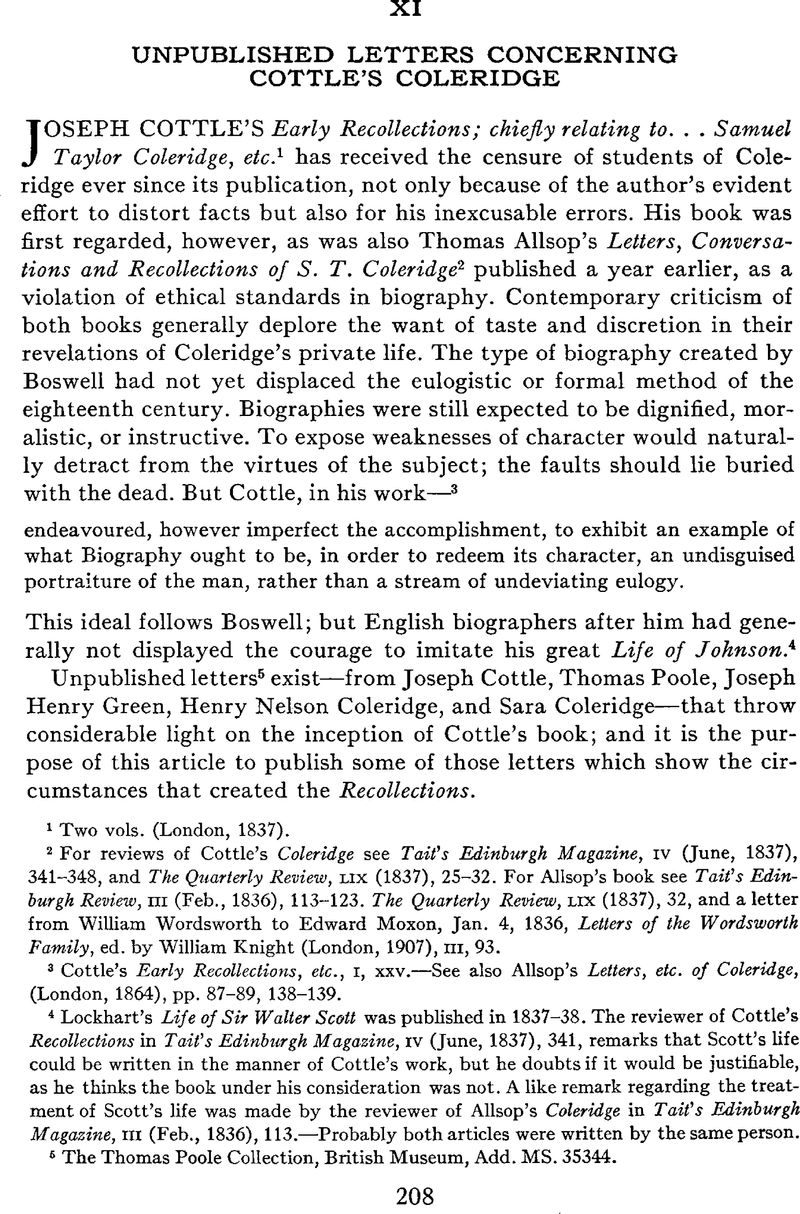Article contents
Unpublished Letters concerning Cottle's Coleridge
Published online by Cambridge University Press: 02 December 2020
Abstract

- Type
- Letter
- Information
- Copyright
- Copyright © Modern Language Association of America, 1934
References
1 Two vols. (London, 1837).
2 For reviews of Cottle's Coleridge see Tait's Edinburgh Magazine, iv (June, 1837), 341–348, and The Quarterly Review, lix (1837), 25–32. For Allsop's book see Tait's Edinburgh Review, iii (Feb., 1836), 113–123. The Quarterly Review, lix (1837), 32, and a letter from William Wordsworth to Edward Moxon, Jan. 4, 1836, Letters of the Wordsworth Family, ed. by William Knight (London, 1907), iii, 93.
3 Cottle's Early Recollections, etc., i, xxv.—See also Allsop's Letters, etc. of Coleridge, (London, 1864), pp. 87–89, 138–139.
4 Lockhart's Life of Sir Walter Scott was published in 1837–38. The reviewer of Cottle's Recollections in Tait's Edinburgh Magazine, iv (June, 1837), 341, remarks that Scott's life could be written in the manner of Cottle's work, but he doubts if it would be justifiable, as he thinks the book under his consideration was not. A like remark regarding the treatment of Scott's life was made by the reviewer of Allsop's Coleridge in Tait's Edinburgh Magazine, iii (Feb., 1836), 113.—Probably both articles were written by the same person.
5 The Thomas Poole Collection, British Museum, Add. MS. 35344.
6 2d ed. (London, 1847).
7 Mrs. Henry Sandford in her book, Thomas Poole and his Friend (London, 1888), ii, 303, says that he “almost quarrelled with honest Joseph, who was determined to bring out his very readable, but very indiscreet and inaccurate record, in precisely his own way.”
8 Letter dated “3 Sept. 1834.”—B. M. Add. MS. 35344, p. 110.
9 Such a work does not exist.
10 September 5, 1834, Hampstead. B. M. Add. MS. 35344, p. 104.
11 B. M. Add. MS. 35344, p. 112.
12 B. M. Add. MS. 35344, p. 104. This letter is not in Poole's handwriting. Punctuation and spelling in all the letters published here have not been corrected or changed.
13 Coleridge had willed to Poole a ring.
14 B. M. Add. MS. 35344, i, 202.
15 B. M. Add. MS. 35344, i, 206.
16 “S. T. Coleridge in Company with Socinians and Atheists,” Congregational Magazine (August, 1835) pp. 486–490.—An editorial note states that the article was taken from Joseph Cottle's recently published volume, entitled, “On the Predictions and Miracles of Jesus Christ, with References to Sceptics, Infidels, and Socinians, by a Layman.”
17 B. M. Add. MS. 35344, i, 208.
18 Nathan Branwhite (fl. 1825), a miniature painter and engraver of Bristol.
19 B. M. Add. MS. 35344, i, 122.
20 B. M. Add. MS. 35344, ii, 210.
21 Robert Hancock (1730–1817). He lived in Bristol about 1796. This portrait of Coleridge is in the National Portrait Gallery.
22 Peter Vandyke (fl. 1767). He lived in Bristol in late life. His picture of Coleridge is also in the National Portrait Gallery.
23 Washington Allston (1779–1843), an American artist who greatly admired Coleridge. His portrait of Coleridge was made by the order of Josiah Wade, in Bristol in 1814. It hangs now in the National Portrait Gallery.
24 B. M. Add. MS. 35344, ii, 212.
25 B. M. Add. MS. i, 127.
26 B. M. Add. MS. 35344, i, 129.
27 B. M. Add. MS. 35344, ii, 214.
28 This loan (not a “gift”) De Quincey proposed in July, 1807, but it was not paid until November. See James Dykes Campbells' Coleridge; A Narrative of the Events of his Life (L., 1894), pp. 163–4. See also Alexander H. Japp's De Quincey Memorials (L., 1891), i, 127–134; and Unpublished Letters of Samuel Taylor Coleridge, ed. by Earl Leslie Griggs (L., 1932), ii, 131 and note, 293 and note.
29 Cottle is evidently referring to S. T. Coleridge's letter to Josiah Wade of June 26, 1814, although he is not quoting accurately. It should read: “After my death, I earnestly entreat, that a full and unqualified narration of my wretchedness, and of its guilty cause, may be made public, that at least some little good may be affected by the direful example.”—Letters of S. T. Coleridge, ed. by E. H. Coleridge, (L., 1895), p. 624.—Cottle, of course, published his own letter from Coleridge in which was an anguished confession of the opium habit. See the letter of April 26, 1814, in Letters of S. T. Coleridge, pp. 616–619.
30 Poole has inscribed this note on the letter: “fr. Cottle, 15th June, 1836. Con. his Narrative relative to Coleridge—a curious letter—see my answer. No man can be more wrong.”
31 B. M. Add. MS., i, 214.
32 This reference may be to Cottle's preceding letter of the 15th of June, as his quotation, the reader will see, is taken from the one of that date. His previous mention of a May 20th letter must be correct, and it is quite possible that Cottle used the same words in the earlier letter. At any rate, I have not found this particular letter.
33 B. M. Add. MS. 35344, ii, 217.
34 B. M. Add. MS. 35344, i, 181.
35 Poole is doubtless referring to the widow of the Rev. John Prior Estlin, whose letters from Coleridge were published in 1884.
- 1
- Cited by


